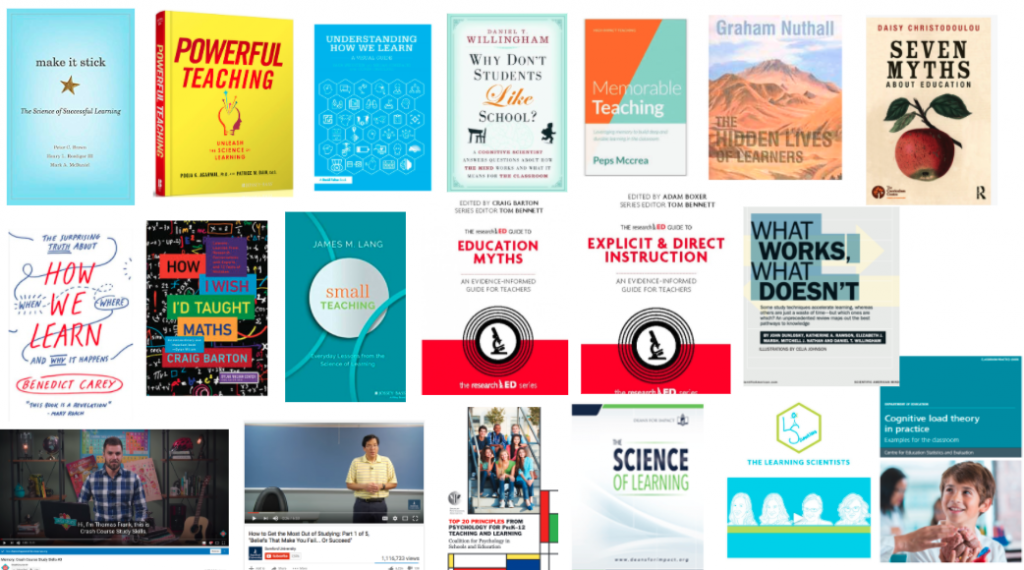In my original blog post (“Wishful Thinking about Far Transfer” ), I looked at the article “If You Learn A, Will You Be Better Able to Learn B?” and thought about how Bruyckere, Kirschner, and Hulshof’s conclusions related to my experience as a teacher and learner. At the end of my blog post, I concluded “Maybe we should just admit that far transfer isn’t likely to happen, and focus on helping students get the specific, contextual training they need to get the skills they want and need.” A few friends (new and old!) shared their thoughts and some references with me, and this feedback is helping me add to my original thinking about the likelihood of far transfer.
These friends shared that they experience (and aim for) transfer with their students in music and arts classes. I got a chance to read the literature music and art educators share in their circles. Some highlights:
- Transfer of Learning and Music Understanding: A Review of Literature: this literature review of studies over the past 40 years attempts to provide an overview of what music education researchers know about what skills transfer to other contexts. The contexts studied are often “within” the general area of music, e.g. “transferring knowledge and skills from one type of ensemble to another; performing a new music genre or style; to composing in a variety of styles and for different ensembles” This quote from the conclusion section stuck with me: “Achieving transfer in music is largely dependent on the nature of instruction and the emphasis on schemata, reflection, motivation, and practice.”
- Learning in and through the Arts: The Question of Transfer, Studies in Art Education: this ambitious mixed methods study looked at correlations and connections between “high art” (students who experienced a high level of arts exposure and education) and “low art” students. The authors found several significant positive correlations between arts exposure and cognitive measures of creativity and other thinking skills. These findings are aligned with other studies about the correlations between arts exposure and positive academic outcomes (Catterall, 1998). They point out that they can’t make causal inferences based on these quantitative data and used qualitative analysis to investigate these correlations. One of their more interesting conclusions is: “In tasks which share common cognitive or symbolic elements, or underlying abstract structures, transfer is more likely to occur “
- Cognitive Transfer from Arts Education to Non-arts Outcomes: Research Evidence and Policy Implications. Handbook of Research and Policy in Art Education: a summary of 10 meta-analyses of the effects of arts instruction on non-arts thinking skills. Conclusion: “Three analyses demonstrate generalizable, causal relationships: achievement, music listening and spatial reasoning, and music learning and spatial reasoning. Five do not allow causal conclusions: multi-arts and academic achievement, arts rich instruction and creativity, visual arts and reading, dance and reading, music and reading. Findings for two analyses are equivocal: dance and spatial reasoning, music and mathematics.”
I’m grateful for this feedback because I didn’t know about these large-scale efforts to investigate far transfer in the context of arts and music education. These findings make me wonder about the terminology I used in my blog post and in the original Bruyckere, Kirschner, and Hulshof article. I concluded that the article matched my experience as a teacher and learner and “we should just admit that far transfer isn’t likely to happen.” Now I wonder if maybe there is a more productive way of thinking about this topic: instead of focusing on the term “far transfer” and concluding that it “does” or “doesn’t” happen, maybe it would be more productive to ask a question like “What skills DO transfer, and what teaching/learning conditions encourage that transfer?” Would it be useful to set aside the concern about whether transfer is “near” or “far,” and talk about educational contexts that seem to encourage specific kinds of transfer, and learn from those contexts and examples?
This concern about terminology – how “far” does transfer have to be before it’s “far” transfer, and is that distinction important? – reminds me of a similar (maybe) issue in memory research: Craik and Lockhart’s levels of processing theory was criticized because it became difficult to operationalize differences between “deep” and “shallow” processing in their model. For years, I dutifully taught about the levels of processing theory in my introductory psychology class and this critique of the theory. But my students found the concept of deep processing useful, and our in-class activities and labs generated evidence that deep processing was useful. Some students reported using deep processing theory to modify their studying habits. Now I work with teachers and deep processing is turning into a useful way to think about tasks teachers ask students to do. Maybe defining the line between deep and shallow processing is less important in practice than talking about what kinds of processing lead to better encoding. In a similar way, maybe arguing about what constitutes the difference between near and far transfer is less important than looking at contextualized examples of transfer and establishing what teaching and learning elements encourage productive transfer of skills?
References
Catterall, J.S. (1998). Involvement in the arts and success in secondary school. Americans for the Arts Monographs, 1(9), 1-10.
Craik, F. I. M., & Lockhart, R. S. (1972). Levels of processing: A framework for memory research. Journal of Verbal Learning and Verbal behavior, 11, 671-684.
Forrester, S.H. (2018) Transfer of Learning and Music Understanding: A Review of Literature, Applications of Research in Music Education, 37:1, 30-35
Judith M. Burton, J.M, Horowitz, R., & Abeles, H. (2000) Learning in and through the Arts: The Question of Transfer, Studies in Art Education, 41:3, 228-257
UPDATE: This YouTube video of D. Willingham and D. Daniel talking about a recent meta-analysis regrading far transfer and music training is relevant to this discussion: The Daniels on Research, episode 8: Does Musical Training Make You Smart?

